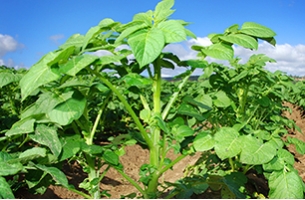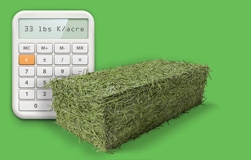K Management in Alfalfa is Paramount for Production
While nothing can guarantee a perfect growing season, potassium (K), one of alfalfa’s most essential nutrients, is key in maximizing alfalfa quality and production.
Apply Optimal K Rates
With increasing input and operation costs, many farmers may be tempted to reduce fertilization on hay and pasture fields. But potassium is vital to stand persistence and longevity[1] and the Michigan State University Extension, warns alfalfa is less drought tolerant and winter hardy when low in potassium[2].
Test Potassium and Sulfur Levels – Apply Accordingly
Adequate fertilizer applications, as well as conducting soil and tissue testing to track nutrient levels are paramount in alfalfa crop management. In the absence of both, production can suffer and coincidently, leave nutrient deficiencies when rotating out alfalfa to another crop.
With alfalfa in particular, both potassium and sulfur play a pivotal role in quality production. With potassium specifically, the nutrient requirement is so high, large amounts are removed from soil (approximately 60 lbs. K is removed per ton of hay according to University of California – Davis)[3] – requiring significant replenishment. And, when it comes to sulfur, over the past few decades regulations have actually reduced sulfur emissions into the atmosphere, which also has led to reduced sulfur deposition in the soil - showing up as deficiencies in plants.
In fact, in a study conducted by the University of Wisconsin, 39 alfalfa tissue samples were collected from 19 Wisconsin counties, with 37 samples collected prior to first cutting (May 19 to June 10) and two collected prior to second cutting (June 28 to July 13). After being analyzed, the samples indicated low K concentrations in 75 percent of alfalfa tissue. In the same study, low sulfur concentrations were also low in 88 percent of tissue samples[4]. To view the full study click here[5].
With alfalfa’s high K rate removal from the soil, coupled with sulfur deficiencies becoming more prominent, adequate nutrient replenishment is necessary. Nutrient application rates should be based on soil and tissue analysis. It is recommended that growers consult with their local extension agent to review testing analyses and determine rates specific to crop and soil requirements.
K Source Matters
When it comes to fertilization, retailers have important fertility recommendations to make. For potash, there are two dominant sources among others, offered in the U.S. marketplace with distinguishable differences. One common source of K is muriate of potash (MOP), which is composed of potassium and chloride in the form of charged atoms, and therefore in the form of a salt that is water soluble.[6] The other major form of potassium is sulfate of potash (SOP), which is considered a higher-quality K fertilizer because it is a dual nutrient supply. Protassium+® premium SOP not only delivers high potassium but also delivers readily available sulfate sulfur, both of which are crucial in alfalfa production.
The other defining difference between the two forms of potash is the salinity index. In high-saline soils, on irrigated land where highly saline water is applied, or during droughty weather conditions, excess salts can build up in soils, only to be compounded with an application of MOP – leading to toxic levels in plants.
Alternatively, Protassium+ SOP, which contains virtually no chloride and a low salt index, can help minimize the damage that salt can do to an alfalfa plant’s root structure and the soil system can better retain its integrity under those conditions.
Learn more about Protassium+ premium SOP.
[1] http://www.ipni.net/ppiweb/ppinews.nsf/0/767dc5e7c2da73cd8525691c005b672a/$FILE/98110-MultiReg-Alfalfa.pdf
[2] http://msue.anr.msu.edu/news/still_time_to_soil_test_hay_fields
[3]http://alfalfa.ucdavis.edu/+symposium/proceedings/2006/06-163.pdf
[4] http://www.hoards.com/E_crops/cf34
[5]http://www.midwestforage.org/pdfRschProj/2010WisconsinAlfalfaPlantAnalysisSurvey-Clark.pdf
[6]http://www.icpotash.com/learning-center/potash




